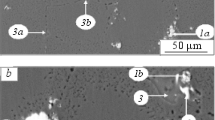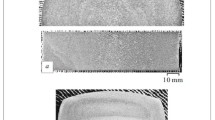Abstract
In X-ray analysis of ternary Sn-Pb-Sb alloys it is neccesary to consider two main sources of error. The first one is the smearing which arises out of the varying hardness of the constituents of the matrix and takes place during the preparation of the sample surface by turning or milling. The second one concerns the variation of the matrix due to segregation effects, occuring during storage of samples. The X-ray intensity of tin increases with time as a result of these segregation effects, whilst that of lead remains practically constant.
The first mentioned difficulty can be avoided by cooling the samples with liquid nitrogen immediately prior to turning. Reproducible sample surfaces can also be achieved by compressing turnings with a vacuum pressing tool.
Investigations are made of the system Sn-Pb-Sb, with Sn contents between 2 and 90% and Sb contents up to 15%. Comparisons of measurements made on compressed turnings with the results of chemical analysis of tin showed that for ca. 90% of the samples the deviations were less than ± 0,5% rel.
To avoid errors arising out of the varying of the matrix it is necessary to construct the calibration curves for freshly cast alloys using samples at the most one day old, as the variation in intensity three days after casting may be expected to exceed the 3 σ-limit of the counting statistics.
Zusammenfassung
Bei der Röntgenspektralanalyse ternärer Sn-Pb-Sb-Legierungen hat man zwei Fehlermöglichkeiten zu beachten: die erste besteht darin, daß bei spanabhebender Bearbeitung zur Herstellung einer repräsentativen Meßoberfläche infolge der unterschiedlichen Weichheit der Gefügebestandteile Überschmierungen auftreten; die zweite in Gefügeänderungen durch Segregatbildung beim Lagern der Proben. Die Zinnintensität steigt infolge der Konzentrationsverschiebungen in der fluorescierenden Probenschicht mit der Auslagerungsdauer an, die Bleiintensität bleibt dagegen praktisch konstant.
Die zuerst genannte Schwierigkeit kann durch das Abdrehen von mit flüssigem Stickstoff gekühlten Proben umgangen werden. Gut reproduzierbare Meßoberflächen erhält man außerdem durch das Pressen von Drehoder Frässpänen zu kompakten Tabletten in einem Vakuumpreßwerkzeug.
Untersucht wurde das System Sn-Pb-Sb mit Sn-Gehalten von 2–90% und Sb-Gehalten bis etwa 15%. Der Vergleich mit chemischen Analysenwerten für Zinn ergab bei Messungen an gepreßten Spänen, daß für ca. 90% der Proben die Abweichungen unter ± 0,5% relativ lagen.
Um Fehler durch Gefügeänderungen auszuschalten, ist es erforderlich, die Eichkurve für die Röntgenspektralanalyse frisch gegossener Legierungen mit Proben aufzustellen, die höchstens 1 Tag alt sind, da vom 3. Tag nach dem Gießen an damit zu rechnen ist, daß die Intensitätsänderungen die 3 σ-Grenze der Zählstatistik überschreiten.
Similar content being viewed by others
Literatur
Beattie, H. J., and R. M. Brissey: Anal. Chem. 26, 980 (1954); vgl. diese Z. 146, 429 (1955).
Hansen, M., and K. Anderko: Constitution of binary alloys, p. 1106. McGraw-Hill Book Comp. 1958.
Hirokawa, K.: Sci. Rep. Tohoku Univ., Serie A 13, 271 (1961); vgl. diese Z. 194, 131 (1963).
—, u. G. Gôto: diese Z. 193, 346 (1963).
Jenkins, R., and P. W. Hurley: 12. Colloquium Spectroseopicum Internationale, Exeter, p. 444. London: Hilger u. Watts Ltd. 1965.
-, and J. L. de Vries: Practical X-ray spectrometry, p. 133f. Philips Technical Library 1967.
Morgen, R. A., and E. H. Roberts: Trans. A.I.M.E. 78, 336 (1928).
Preis, H., u. A. Esenwein: Schweiz. Arch. Angew. Wiss. Techn. 1959, 415.
de Sorbo, W., and D. Turnbull: Acta Metallurgica 3, 495 (1956).
Tögel, K.: Siemens Z. 37, 789 (1963).
—: Siemens Z. 36, 597 (1962).
Torralba, M., J. J. Regidor u. J. M. Sistiaga: Z. Metallkunde 59, 184 (1968).
Turnbull, D., and H. N. Treaftis: Acta Metallurgica 3, 43 (1965).
— —: Trans. A.I.M.E. 212, 33 (1958).
Zanin, S. J., and G. E. Hooser: Appl. Spectroscopy 22, 105 (1968).
Veröffentlichung in Vorbereitung.
Author information
Authors and Affiliations
Additional information
Herrn Dr. G. Kraft und Herrn Dr. F. Odor danken wir für die Förderung dieser Arbeit.
Rights and permissions
About this article
Cite this article
Lüschow, H.M., Steil, H.U. Zur Röntgenspektralanalyse von Zinn-Blei-Antimon-Legierungen. Z. Anal. Chem. 245, 304–311 (1969). https://doi.org/10.1007/BF00440011
Received:
Issue Date:
DOI: https://doi.org/10.1007/BF00440011




